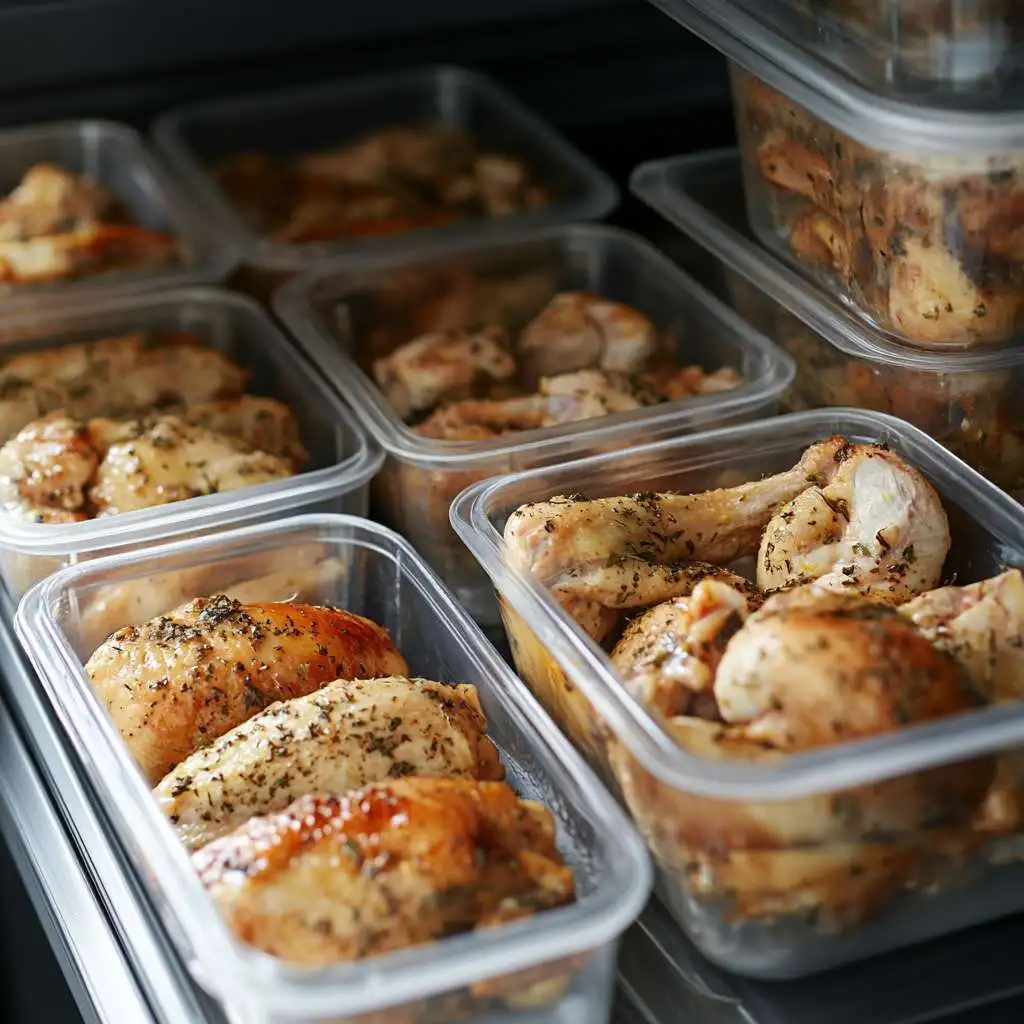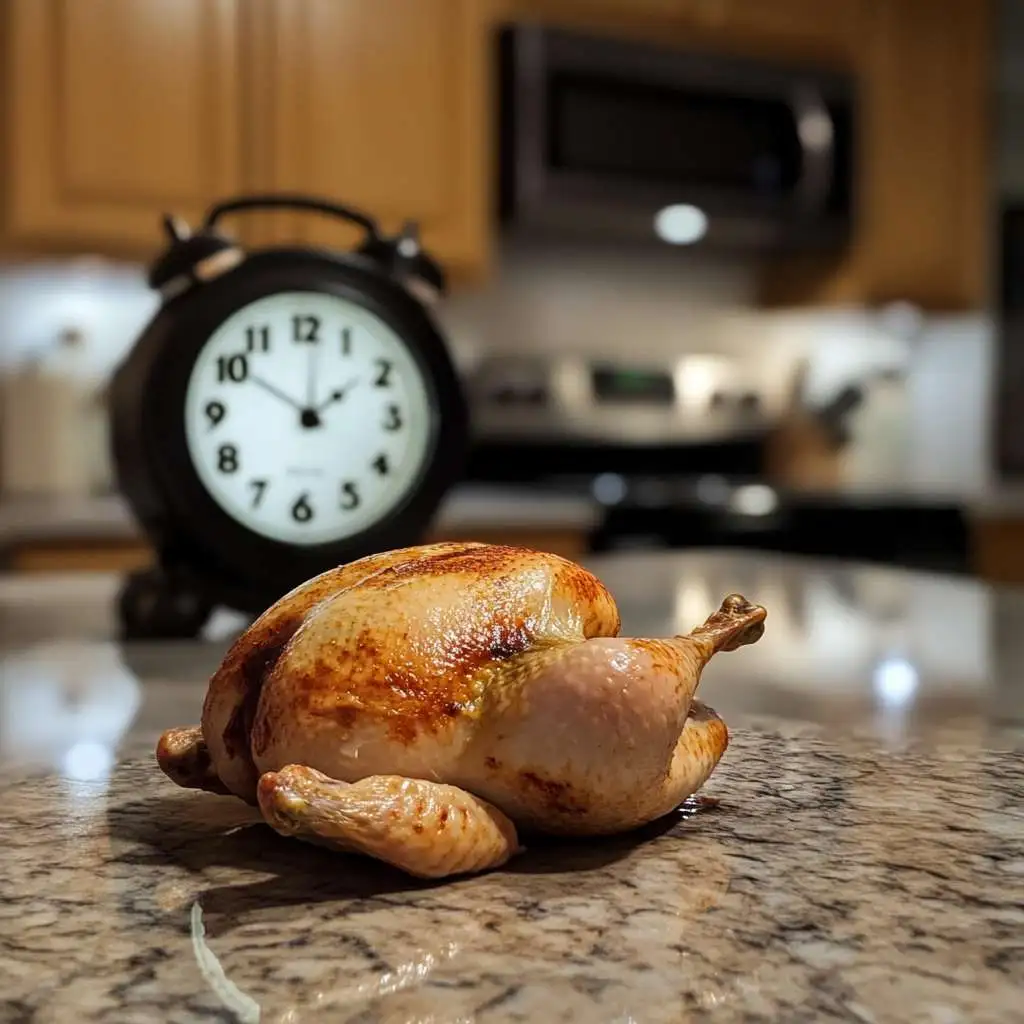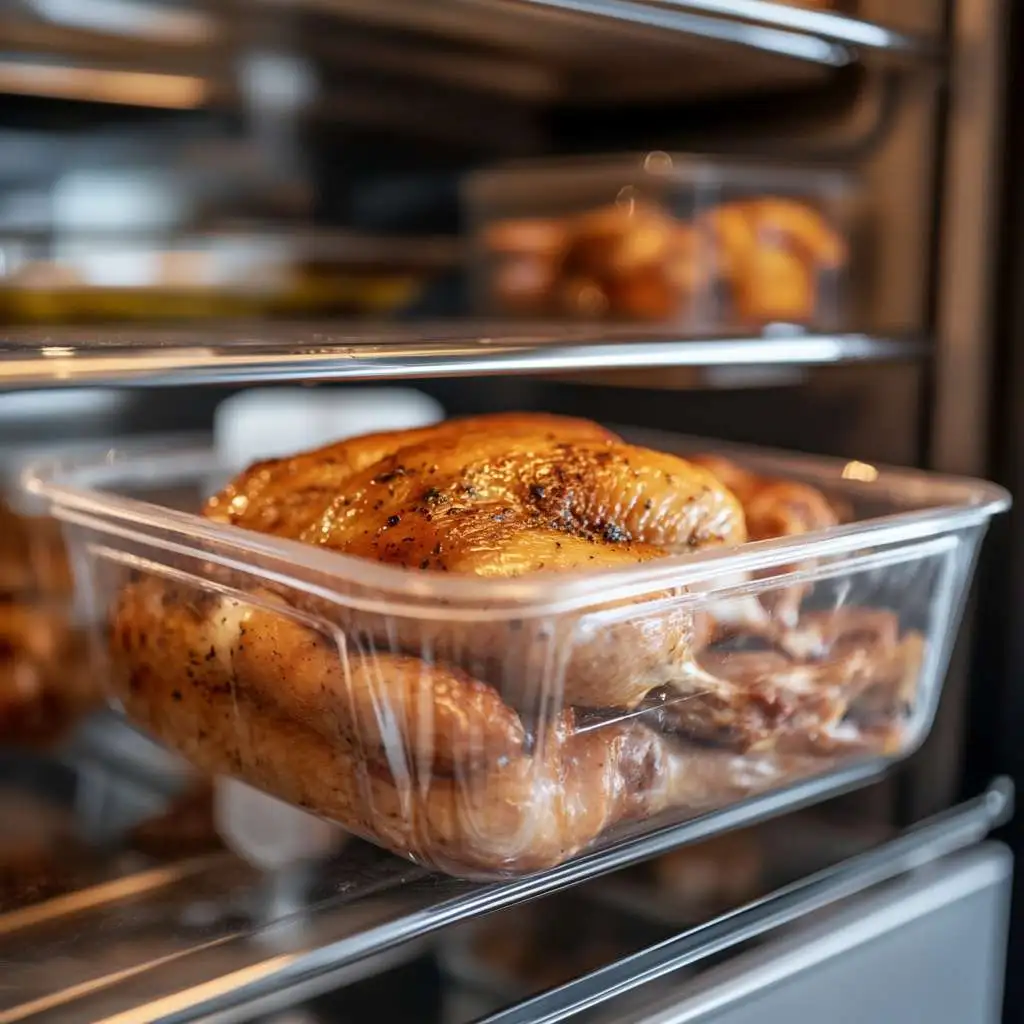How long is leftover rotisserie chicken good in the fridge? If you’ve ever stood in front of your refrigerator wondering whether that delicious rotisserie chicken from last night’s dinner is still safe to eat, you’re not alone. Leftover rotisserie chicken is a convenient and tasty meal option, but storing it properly and knowing when to toss it out is essential for food safety.
In this article, we’re diving deep into the world of leftover rotisserie chicken—its shelf life, proper storage tips, and signs that it’s time to toss it out. By the end, you’ll know exactly what to do with those leftovers to keep yourself and your family safe.
Table of Contents
How Long Can Leftover Rotisserie Chicken Last in the Fridge?
When it comes to food safety, the fridge is your best friend. It slows down bacterial growth, giving you extra time to enjoy your leftovers. But even with refrigeration, rotisserie chicken doesn’t last forever.
General Rule for Storage Duration
Here’s the golden rule: leftover rotisserie chicken is safe to eat for up to 3 to 4 days in the fridge. This is based on the USDA (United States Department of Agriculture) guidelines for cooked poultry. The key here is proper storage, but we’ll get into that in just a minute.
Let’s break this down:
- If you brought home that chicken on Monday night, you should aim to eat the leftovers no later than Thursday.
- By day 5, it’s time to say goodbye—no matter how good it still looks.
Why the strict time frame? Because bacteria like Salmonella and E. coli can multiply quickly, even at fridge temperatures. While the cold environment slows their growth, it doesn’t stop it entirely. After 4 days, the risk of foodborne illness increases significantly.
“When in doubt, throw it out. Your health isn’t worth gambling over a few bites of old chicken.”
Factors That Affect the Shelf Life of Leftover Chicken
So, what determines how long your leftover chicken actually stays safe to eat? Several factors come into play:
Proper Storage Methods
The way you store your rotisserie chicken can make or break its shelf life. Leaving it in the plastic grocery container? Bad idea! Proper storage means transferring the chicken to an airtight container or tightly sealing it with plastic wrap or aluminum foil.
Why? Because exposure to air can introduce bacteria and cause the chicken to dry out faster. Airtight containers not only keep your chicken fresh but also lock out unwanted bacteria.
Temperature of the Fridge
Did you know the temperature of your fridge plays a big role in food safety? The magic number here is 40°F (4°C) or below. Anything above that, and bacteria start to party—quickly.
To make sure your fridge is up to the task, consider keeping a thermometer inside. It’s a small step that makes a big difference.
Freshness of the Chicken When Bought
The fresher the rotisserie chicken was when you bought it, the longer it’ll last. If that chicken sat under heat lamps for hours before you grabbed it, its shelf life will naturally be shorter.
Here’s a quick tip: try to pick up rotisserie chickens that were just prepared. Most stores will label the packaging or announce when fresh chickens are available.
Looking for ways to use your leftovers? Check out these Leftover Rotisserie Chicken Ideas for creative meal inspiration!
Signs That Leftover Rotisserie Chicken Has Gone Bad
Let’s face it: no one wants to eat spoiled food. But sometimes, it’s hard to tell if that leftover rotisserie chicken is still good or if it’s time to toss it. Here are the top signs to watch out for:
Visual Signs of Spoilage
Start with a good look. If you notice any of the following, it’s time to say goodbye:
- Mold or fuzzy patches: Any mold growth—green, white, or black—is a clear sign the chicken has spoiled.
- Discoloration: If the chicken turns gray, greenish, or develops an unusual hue, don’t take any chances.
While slight browning can sometimes occur naturally, anything beyond that is a red flag.
Changes in Smell
Your nose knows! A fresh rotisserie chicken has that mouthwatering, savory aroma. But when it spoils, the smell changes—and not in a good way. If your chicken smells sour, rancid, or just plain funky, trust your instincts and toss it out.
“If the smell makes you hesitate, it’s not worth the risk. Fresh food should never leave you second-guessing.”
Texture and Taste Issues
Sometimes, the chicken might look fine but still be spoiled. If you notice any of these issues while handling or eating the chicken, stop immediately:
- Slimy or sticky texture: Spoiled chicken often feels slimy or tacky to the touch. That’s a big no-no.
- Off taste: If you take a bite and something tastes “off” or sour, don’t push through. Spit it out and get rid of the rest.
Proper Steps to Store Rotisserie Chicken in the Fridge
You’ve got your leftover rotisserie chicken, and now it’s time to store it properly. If you think just tossing it into the fridge in its grocery store container is enough, think again! Proper storage is the key to extending its freshness and ensuring it stays safe to eat.
Using Airtight Containers
First things first: transfer the chicken to an airtight container. The original packaging may be convenient, but it’s not designed for long-term storage. Airtight containers keep out moisture, bacteria, and unwanted odors that could ruin your leftovers.
If you don’t have a container, no worries! You can also tightly wrap the chicken in plastic wrap or aluminum foil. Just make sure there are no gaps where air can sneak in.
If you’re planning meals for the week, here’s a helpful guide: One Rotisserie Chicken, Seven Days of Meals.
Ideal Temperature for Storage
As mentioned earlier, fridge temperature plays a critical role in food safety. Always make sure your refrigerator is set at or below 40°F (4°C). This temperature slows down bacterial growth, giving you those precious 3–4 days to enjoy the chicken.
It’s also a good idea to place the chicken on a lower shelf in the fridge. Why? Because cold air sinks, making the bottom shelves the coldest. Plus, keeping the chicken low reduces the risk of juices dripping onto other foods and contaminating them.
How Long Can You Leave It at Room Temperature Before Refrigeration?
This is where many people slip up. You bring home that delicious rotisserie chicken, eat a meal, and then leave it sitting on the counter “just for a little while.” The truth is, you’ve got a very small window before the chicken enters the danger zone.
The danger zone for food is between 40°F and 140°F (4°C to 60°C)—the perfect temperature range for bacteria to thrive. Leftover chicken should never sit at room temperature for more than 2 hours. If it’s a hot day (above 90°F), that window shrinks to 1 hour.
To stay on the safe side, refrigerate the chicken as soon as possible after eating. If you’re not planning to eat it within 3–4 days, consider freezing it instead.
Remember: “When it comes to food safety, time and temperature are everything. The faster you chill your chicken, the safer it’ll be.”
Freezing Rotisserie Chicken: An Alternative Solution
If you know you won’t eat your leftover rotisserie chicken within a few days, don’t throw it out—freeze it! Freezing is an excellent way to extend its shelf life and prevent food waste. Let’s look at how to freeze chicken properly and how long it’ll last in the freezer.
How to Properly Freeze Leftover Rotisserie Chicken
Freezing chicken isn’t complicated, but there are a few steps to ensure it stays tasty and safe:
- Cool the Chicken First: Let the chicken cool completely to room temperature, but don’t let it sit out for more than 2 hours.
- Divide into Portions: Separate the chicken into meal-sized portions. This makes it easier to thaw only what you need later.
- Wrap It Up: Use freezer-safe containers or wrap the chicken tightly in plastic wrap, followed by aluminum foil. You can also use freezer bags—just be sure to press out as much air as possible before sealing.
- Label It: Write the date on the container or bag. Trust me, you’ll thank yourself later when you’re trying to figure out how long it’s been sitting in the freezer.

How Long Can Frozen Rotisserie Chicken Last?
Frozen cooked chicken can last up to 4 months in the freezer while maintaining its best quality. After that, it’s still safe to eat, but the flavor and texture may start to decline.
To thaw frozen chicken, move it to the fridge and let it defrost overnight. Never thaw chicken at room temperature, as this can encourage bacterial growth.
Quick Tip: If you’re in a hurry, you can use the defrost setting on your microwave. Just be sure to reheat the chicken immediately afterward to avoid any safety risks.
How to Safely Reheat Leftover Rotisserie Chicken
Once you’ve stored your leftover chicken properly, the next challenge is reheating it without drying it out. Dry, rubbery chicken? No, thank you! Here are the best methods for reheating rotisserie chicken while keeping it juicy and delicious.
Using the Oven for Reheating
The oven is hands down the best method for reheating rotisserie chicken. It warms the chicken evenly and helps maintain its crispy skin. Here’s how to do it:
- Preheat your oven to 350°F (175°C).
- Place the chicken in an oven-safe dish and cover it loosely with foil. This prevents the chicken from drying out.
- Heat for about 20–25 minutes or until the internal temperature reaches 165°F (74°C).
If you want to crisp up the skin, remove the foil during the last 5 minutes of reheating.
Using the Microwave or Air Fryer
If you’re short on time, the microwave or air fryer can save the day:
- Microwave: Place the chicken in a microwave-safe dish with a splash of water or broth. Cover with a microwave-safe lid or damp paper towel and heat in 30-second intervals until warm.
- Air Fryer: Set the air fryer to 350°F and heat for about 4–5 minutes. This is great for bringing back the crispy texture without drying the chicken out.
Safety Tips When Reheating Chicken
Regardless of the method you use, always follow these safety tips:
- Check the Temperature: Use a food thermometer to ensure the chicken reaches an internal temperature of 165°F (74°C). This kills any harmful bacteria.
- Avoid Reheating Multiple Times: Reheating chicken more than once can reduce its quality and increase the risk of foodborne illness. Only heat what you plan to eat.
Fun Fact: The air fryer isn’t just for reheating chicken; it can also make leftover chicken taste freshly roasted again. Talk about a kitchen superhero!
Common Mistakes People Make When Storing Leftover Chicken
It’s easy to think storing rotisserie chicken is foolproof, but even small mistakes can turn a tasty meal into a food safety nightmare. Let’s look at the most common errors and how you can avoid them.

Not Storing It in Airtight Containers
One of the biggest mistakes people make is leaving leftover chicken in the grocery store’s plastic container or on a plate loosely covered with foil. This allows air and moisture to interact with the chicken, which can dry it out or allow bacteria to grow.
Solution: Always transfer leftover chicken to an airtight container or wrap it tightly in plastic wrap and aluminum foil. This ensures freshness and blocks out bacteria.
Leaving Chicken at Room Temperature Too Long
We’ve all been there: you finish dinner, get distracted, and realize hours later that the chicken is still sitting on the counter. Unfortunately, chicken left at room temperature for more than 2 hours (or 1 hour in hot weather) enters the “danger zone” where bacteria multiply rapidly.
Solution: As soon as you’re done eating, refrigerate the leftover chicken. It’s always better to be safe than sorry. If you’re unsure how long it sat out, toss it.
“Remember: If it’s been sitting out longer than 2 hours, don’t even think about putting it in the fridge. It’s not worth the risk!”
Forgetting to Check for Spoilage Signs
Sometimes people assume that if food looks okay, it must still be safe to eat. Spoiled chicken doesn’t always scream “bad” with visible mold—it might smell slightly off or have a slimy texture you only notice when handling it.
Solution: Always trust your senses. Check for changes in appearance, texture, and smell before eating any leftovers. If anything feels off, toss it.
Reheating Chicken More Than Once
Reheating leftover chicken multiple times might seem harmless, but each time you do, the quality worsens, and bacteria can multiply. Plus, repeatedly heating food can dry it out, making it less appetizing.
Solution: Only reheat the portion you plan to eat. If you’ve stored the chicken in smaller portions, this will be easier and more convenient.
Health Risks of Eating Spoiled Leftover Rotisserie Chicken
Eating spoiled chicken is more than just unpleasant—it can seriously harm your health. Let’s explore the potential risks and what symptoms you should watch out for.
Food Poisoning and Bacterial Growth
When chicken spoils, it becomes a breeding ground for harmful bacteria like:
- Salmonella
- Listeria
- Staphylococcus aureus
These bacteria can cause food poisoning, which comes with a host of unpleasant symptoms.
Symptoms to Watch Out For
If you’ve eaten spoiled chicken, symptoms of food poisoning may include:
- Nausea and vomiting
- Diarrhea
- Stomach cramps
- Fever and chills
These symptoms can appear within a few hours or up to 24–48 hours after eating bad food. In severe cases, food poisoning can lead to dehydration, hospitalization, or more serious complications.
What should you do? If you suspect food poisoning, drink plenty of water to stay hydrated. For severe symptoms (high fever, prolonged vomiting, or bloody stool), seek medical attention immediately.
“Food poisoning is no joke. Always prioritize food safety over saving a few bites of leftovers.”
Frequently Asked Questions (FAQs)
Can I Eat Rotisserie Chicken After 5 Days?
No. While the chicken might look fine, it’s best not to eat it after 4 days in the fridge. The USDA guidelines are clear—cooked chicken should be consumed within 3–4 days for safety. After that, the risk of harmful bacteria increases significantly.
How Can I Tell If My Rotisserie Chicken Is Still Safe?
Check for these signs of spoilage:
- Appearance: Mold or discoloration.
- Smell: Sour, rancid, or funky odor.
- Texture: Slimy or sticky feel.
If any of these are present, it’s time to throw it out.
Is It Better to Freeze or Refrigerate Leftover Chicken?
It depends on when you plan to eat it.
- Refrigerate if you’ll eat it within 3–4 days.
- Freeze if you want to store it for longer. Frozen rotisserie chicken can last up to 4 months without losing quality.
Can I Reheat Rotisserie Chicken Multiple Times?
Technically, yes—but it’s not recommended. Repeated reheating can dry out the chicken and increase the risk of bacteria growth. It’s better to reheat only the portion you plan to eat.
How Long Can I Leave Rotisserie Chicken at Room Temperature?
Leftover chicken should not sit at room temperature for more than 2 hours. If the room temperature is above 90°F (32°C), that window shrinks to just 1 hour. After that, bacteria multiply quickly, making the chicken unsafe to eat.
Conclusion
So, how long is leftover rotisserie chicken good in the fridge? The answer is 3–4 days when stored properly. By using airtight containers, refrigerating promptly, and keeping your fridge at the right temperature, you can enjoy your delicious rotisserie chicken leftovers safely.
Remember to check for spoilage signs before eating and avoid common storage mistakes like leaving the chicken out for too long. If you won’t eat it within a few days, freezing is a great option to extend its shelf life.
At the end of the day, food safety comes first. By following these simple tips, you can make the most of your leftovers without risking your health. Enjoy that juicy rotisserie chicken—just don’t let it overstay its welcome in the fridge! 🐔
“When it comes to leftovers, fresh is best, and safety is key. Happy eating!”



